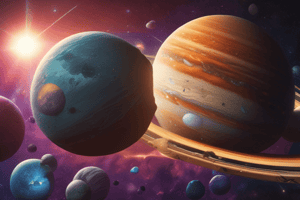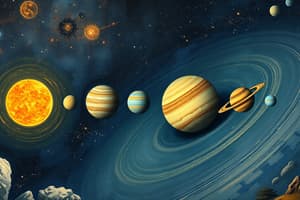Podcast
Questions and Answers
ما هو عدد الكواكب التي تدور حول الشمس في نظامنا الشمسي؟
ما هو عدد الكواكب التي تدور حول الشمس في نظامنا الشمسي؟
- ٨ كواكب (correct)
- ٦ كواكب
- ٥ كواكب
- ٧ كواكب
أي من الكواكب التالية يُعتبر كأكبر كوكب في النظام الشمسي من حيث الحجم؟
أي من الكواكب التالية يُعتبر كأكبر كوكب في النظام الشمسي من حيث الحجم؟
- المريخ
- زحل (correct)
- الزهرة
- عطارد
ما هو الكوكب الذي يُطلق عليه لقب 'الكوكب الأحمر' وله دلالات على وجود المياه عليه؟
ما هو الكوكب الذي يُطلق عليه لقب 'الكوكب الأحمر' وله دلالات على وجود المياه عليه؟
- زحل
- عطارد
- الأرض
- المريخ (correct)
أي من الكواكب التالية يُعتبر كأقرب كوكب إلى الشمس؟
أي من الكواكب التالية يُعتبر كأقرب كوكب إلى الشمس؟
ما هي المدة التي تستغرقها كوكبة فينوس لإكمال دورتها حول الشمس؟
ما هي المدة التي تستغرقها كوكبة فينوس لإكمال دورتها حول الشمس؟
ما هو نوع كوكب المشتري من حيث التركيب؟
ما هو نوع كوكب المشتري من حيث التركيب؟
ما الخاصية التي يجب توفرها للكوكب حسب الاتحاد الفلكي الدولي؟
ما الخاصية التي يجب توفرها للكوكب حسب الاتحاد الفلكي الدولي؟
أي من الكواكب التالية لا يعتبر كوكبًا ضمن التصنيف الجوفي؟
أي من الكواكب التالية لا يعتبر كوكبًا ضمن التصنيف الجوفي؟
ما هو المطلب الذي تضعه الاتحاد الفلكي الدولي لكي يُصنَّف كوكبًا؟
ما هو المطلب الذي تضعه الاتحاد الفلكي الدولي لكي يُصنَّف كوكبًا؟
أي من الكواكب التالية هو عملاق جليدي بعيد عن شمسنا؟
أي من الكواكب التالية هو عملاق جليدي بعيد عن شمسنا؟
ما هي صفة تصنيف الكواكب الترابية؟
ما هي صفة تصنيف الكواكب الترابية؟
ما الذي يجعل كواكب المجموعة الشمسية تختلف عن الأقمار والكويكبات؟
ما الذي يجعل كواكب المجموعة الشمسية تختلف عن الأقمار والكويكبات؟
Study Notes
Planets: Exploring Our Solar System's Diverse Worlds
Nestled within the vastness of our cosmos, planets are celestial bodies that orbit stars—in our case, our Sun—and hold the potential for harboring life. As we delve into the wonders of our solar system, we'll first lay foundation by exploring its layout and the universal classification that helps us understand the intricate dance of planets.
The Solar System
The solar system, our own resident cosmic neighborhood, consists of the Sun, a variety of planets, moons, asteroids, and comets. The planets orbit the Sun at different distances, while the Sun itself is a medium-sized star, providing the energy and stability that makes life possible across our system.
Our solar system is divided into four main regions:
- Mercury: The closest planet to our Sun, Mercury is a small, rocky world with an orbit that takes less than three months to complete.
- Venus: Often referred to as Earth's "sister planet," Venus circles our Sun every 243 Earth days, but its thick atmosphere creates extreme conditions.
- Earth: Our home, a watery world with a temperate climate and diverse ecosystems, including us humans.
- Mars: The Red Planet, Mars is a dry and dusty world with a thin atmosphere, but evidence of water has been found, sparking hopes of ancient life and future habitability.
Beyond Mars, we find the Jovian planets:
- Jupiter: The largest planet in the solar system, Jupiter is gaseous and may contain a solid core.
- Saturn: Known for its iconic rings made of ice particles, Saturn is also a gaseous planet and home to several moons, including Titan.
- Uranus: This icy giant orbits our Sun at a tilt, resulting in seasons that last for decades, if not centuries.
- Neptune: The eighth and last planet in our solar system, Neptune is an icy giant that is the farthest known planet from our Sun.
Planet Classification
The International Astronomical Union (IAU) defines planets based on their properties and orbits around the Sun. According to the IAU, a planet must:
- Orbit the Sun.
- Be a spheroid in shape.
- Have cleared its orbit of other celestial bodies—in other words, no large moons orbiting it.
- Not be a star.
These criteria help us separate planets from other celestial bodies, such as moons, asteroids, and comets. Planets can be further classified into two main categories: terrestrial and Jovian.
Terrestrial planets are smaller, rocky worlds that orbit close to the Sun. They include Mercury, Venus, Earth, and Mars. Jovian planets, on the other hand, are larger, gaseous worlds like Jupiter, Saturn, Uranus, and Neptune.
In our ongoing quest to explore and understand our cosmos, we continue to discover new and fascinating aspects of our solar system's diverse collection of planets. The connection between our planetary neighbors and the possibility of life beyond Earth brings us closer to a deeper understanding of our place in the universe.
Studying That Suits You
Use AI to generate personalized quizzes and flashcards to suit your learning preferences.
Description
Delve into the fascinating world of planets in our solar system, from the rocky terrains of Mercury and Mars to the gaseous giants like Jupiter and Saturn. Learn about planet classification, the International Astronomical Union's criteria, and the unique characteristics that define each celestial body.




